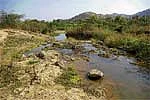
Jwalapuram, a village in Andhra Pradesh has been drawing crowds of experts. The village is a subject of interest to scientists, paleobotanists and archaeologists alike as the dust of the great Toba tuff volcano in lake Toba (Sumatran Islands, Indonesia) thousands of years ago is buried here.
Volcanoes have always been destructive in nature, but this ancient one has been able to throw light on the way early man lived in India. Researchers from Karnatak University, Dharwad (KUD) headed by Ravi Koreshetty and Prof Michael Petrogalia’s team from Cambridge University camped here for several months and have been able to date the early human settlement in India using this volcanic ash.
Koreshetty, a leading archaeological researcher from KUD, who stumbled upon this volcanic ash in 2003, found the earliest human settlement beneath this ash. He scoured the caves at Jwalapuram, limestone quarries and Yaganti caves in Kurnool district and came across the volcanic ash, which is the second such discovery in the country after he discovered the same ash at Pune in 1987.
Volcano Young Toba Tuff (YTT) was probably the most explosive one in the history of the earth and measured eight on the Volcanic Explosivity Index (VEI). It exploded 74,000 years ago in Lake Toba.
Modern human migration began in Africa about 1,50,000 years ago. Modern homo sapiens moved towards north Africa to the Green Sahara, but the group was put to an end 90,000 years ago because of the global freeze-up at Levant. But 85,000 years ago, another group crossed the Red Sea and reached India. They probably reached this site in Jwalapuram about 80,000 years ago. The middle Paleolithic people in that area were probably killed in big numbers or displaced from that site when a great volcano erupted.
Shetty says, “The ash which remained in the air for six years caused the temperature to plummet. It got deposited in the whole of the Indian subcontinent measuring about 10 feet or more.”
“The ash can be seen at Jwalapuram as it hardened and settled 2.5 metres below the earth. We have found several stone age implements beneath it. Anything below is older and anything above it is younger: this is the significant factor that establishes the migration of modern human beings to India from Africa. For the first time, we have been able to establish the dates of human settlements in the country,” he explained. On the ash itself, he said, “This ash is mined and used as a detergent, it is a fine powder and used in the soap industry. It is also used as a metal polisher.” For scientists, the focus is on the impact of such ash as it remained buried under river sediments, and in turn buried the ecosystem of the region. “As long as it was in the atmosphere, it insulated the solar rays and caused a drastic change in climate, leading to the extinction of various plants and animals,” the researcher said.
The ash fell at Jwalapuram on its rocky surface and water. The rocks got eroded and settled in the water. “We have found fossils of plants and tools used by early man, but so far no animal fossil has been discovered. The discovery is significant because for the first time, experts are able to date the mid-palaeolithic culture in India to 80,000 years, which was totally unknown,” the researcher said. The oldest human (homo habilis) evidence dates back to 2.5 million years in Africa. He lived in Africa eight million years ago.
Homo erectus, who lived 1.5 million years ago made new tools, hand axes and cleavers.
He ventured out of Africa to Eurasia, Europe and spread into South Asia and other regions. “This group did not come to India, but it was homo sapiens whose origin is traced to Africa 150,000 years ago. He moved out of Africa and colonised the world. The relics of both homo erectus and homo sapiens are found at Jwalapuram,” explains Koreshetty.
“Mid palaeolithic remains have been found below the ash. We have to dig out three-four meters below the surface,” said Shetty. Researchers are now exploring the possibilities of whether the earliest occupation of man can be traced and can be dated. US based Smithsonian University is showing interest in the study.
